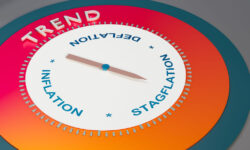I’m going to sound like a high-school economics teacher today. But the world’s central bankers have been very naughty… They’ve completely failed their test to keep inflation under control.
Not long ago, central banking was elementary. Reduce interest rates when inflation is below 2% and raise them when inflation is above 2%. What could go wrong?
Well, clearly, someone needs to do some revision with the central bankers. Reluctantly, I’ve agreed to be the one. So, here goes…
The most important thing to understand about inflation is that it is a rate of change – the first derivative of prices.
It isn’t high prices. It is rising prices – with secondary-school teacher-style emphasis on the “ing”.
Let’s explore the difference.
If prices go up, that’s not inflation. If prices keep going up and up and up persistently over time because the value of money continuously falls, that’s inflation.
Let’s say the price of everything were to suddenly double from one day to the next because of some sort of energy crisis or something similar. This increase is once-off because energy prices cannot keep rising indefinitely. It is just a shock that causes all prices to move and remain elevated, but not to continue rising thereafter.
What would all this look like in terms of inflation as we think about it today?
Well, if prices were to double today and then stay flat thereafter, inflation would be 100% today, but 0% tomorrow.
What would a central banker do when confronted with this situation?
They’d probably panic about 100% inflation today and raise interest rates dramatically. Then they’d probably congratulate themselves that they’d brought inflation back down to 0% tomorrow.But this is a complete misunderstanding of what’s going on. Their interest rates have had no impact.
The oil price shock made prices double, but then the oil price stopped going up and prices stopped going as a consequence too. That’s not inflation, it’s a once-off increase that ends, leaving prices plateaued.
Of course, this is simplified, to say the least. But, given the performance of central bankers lately, simplified is precisely what they need.
In reality, it takes time for actual energy price shocks, and other shifts of supply and demand, to play out through the rest of the economy. We’re not talking about all prices doubling suddenly, we’re talking about prices rising through the economy like ripples across a pond. And not one day to the next, but across months or even years.
But the point remains the same. A once-off price spike causes our measure of inflation to spike and then fall to zero inherently.
True inflation is something very different. It’s the devaluation of money persistently over time, not a once-off price shock. It’s steady price increases as a result of money becoming worth less, not because of prices rising and then remaining high thanks to an energy price shock.
Under inflation, prices take on the appearance of an exponential curve – rising ever faster. Under a supply shock, prices spike and then flatline.
Mistaking these two is dangerous because price spikes caused by energy shocks end as suddenly as they began. And, by the time monetary policy kicks in as it would to slow inflation, the oil price has stabilised and prices have stopped going up as a result.
Sometimes the oil price even falls back down, causing central bankers’ worst fears – deflation. But in such a scenario, it’s just the normalisation of prices. Again, that’s very different to inflation or deflation. Not that it would stop central bankers from panicking about deflating and lowering prices.
Now we can argue about whether we’re seeing true inflation or just a supply shock right now. But it’s clear that central bankers cannot tell the difference. In fact, they are conflating the two issues. And we’re all paying the price.
That’s not to say true inflation isn’t happening or can’t happen. It could also happen at the same time.
The point is that you need to be able to tell the difference between a once-off spike to a higher price level which happens for good reason (rising costs) and a persistent inflation problem which is caused by the devaluation of money – a bad policy decision.
If central bankers don’t make the distinction, they’ll raise interest rates on an economy which is experiencing a sudden spike in costs rather than a sudden but once-off spike in costs. And making debt more expensive only exacerbates costs, as well as undermining the ability to alleviate the energy crisis.
And when prices stop surging because the impact of higher energy prices has made its way through the economy, or falling energy prices have started to make life cheaper again, then central bankers will probably panic again about inflation being too low, or the risk of deflation.
Of course, it’s not just energy that’s moving our prices. Government spending triggered a great deal of inflation too. That’s why nations with more Covid-related economic stimulus experienced more inflation and earlier.
But is government spending a once-off surge like an oil price spike, or is it set to persist year after year, slowly driving up prices all the time?
I might be wrong, but I think the Covid stimulus era is over. Government spending is unlikely to deliver whopping increases in prices as it slams into the economy.
But perhaps I’m wrong about all this. It is possible that the far more insidious true inflation really has begun already. Perhaps the price spike has sparked a panic which triggers true inflation after all as people try to avoid holding money as its value falls.
I do expect this to occur. I just don’t think it has begun yet. Still, if it has, there’s another important lesson which a secondary-school teacher might want to impart, even if it’s much too late.
The real mistake is not to allow inflation to get out of hand, nor the failure to rein it in.
The central bankers’ mistake was to actively cause, fund and bring about the inflation in the first place.
If we’re already seeing true inflation, then it is central banks’ wild monetary policy which is responsible. It triggered the boom in asset prices during the pandemic, with stocks, bonds and property surging to extreme levels. And now it’s causing consumer and producer prices to surge too.
Central banks created and injected vast amounts of funds to bid up prices and spur on lending, especially to governments. A bubble almost always bursts and almost never deflates in an orderly fashion: the blame should go to those inflating it in the first place, not those who fail to rein it in or deal with the consequences when it bursts.
What all of this amounts to is that the people who have been busily guaranteeing our financial systems, our governments and our day-to-day lives are suddenly caught out getting things completely wrong. They don’t understand the basics.
And that’s why markets are in such turmoil. Confusion reigns.
Understanding what’s actually going on, and understanding how central banks have got it wrong, is the key to unlocking how to invest as a result. You need to understand both, though, given how powerful central banks are and how involved they are in market prices.
Tomorrow, we’ll dig into the next phase of the crisis, with some inspiration from what’s going on in Japan.
For now, consider that an amount of monetary gunpowder that would have impressed Guy Fawkes is sitting under the Bank of England. The debate above is whether it has ignited or is still waiting to ignite.
In my view, the once-off price spike we’re seeing now may be the spark it needs to ignite. In which case, central bankers are in for the inflationary surprise of a lifetime.
But what if none of this matters to investors?
That might seem like a pipe dream. But not all investments care about inflation or central bankers.
Some are so leveraged to another factor that investors might not even notice spikes in interest rates, recessions or inflationary breakouts when they look back at the price chart.
They are simply not correlated to macroeconomic conditions like the rest of the market.
Find out what these investments are, here…

Nick Hubble
Editor, Fortune & Freedom




